Indian Elephant
Elephas maximus indicus
Found throughout south-east Asia!
Advertisement
Indian Elephant Scientific Classification
- Kingdom
- Animalia
- Phylum
- Chordata
- Class
- Mammalia
- Order
- Proboscidea
- Family
- Elephantidae
- Genus
- Elephas
- Scientific Name
- Elephas maximus indicus
Read our Complete Guide to Classification of Animals.
Indian Elephant Conservation Status
Indian Elephant Facts
- Main Prey
- Grass, Fruit, Roots
- Distinctive Feature
- Long trunk and large feet
- Habitat
- Rainforest and tropical woodland
- Predators
- Human, Tiger
- Diet
- Herbivore
- Average Litter Size
- 1
- Lifestyle
- Herd
- Favorite Food
- Grass
- Type
- Mammal
- Slogan
- Found throughout south-east Asia!
View all of the Indian Elephant images!
Indian elephants are incredibly intelligent and expressive.
Indian elephants are greyish-black animals that are subspecies of the Asian elephant. They are about 6.6 to 11.5 feet in height and weigh about 6000 to 11,000 pounds.
These elephants go by the scientific name Elephas maximus indicus and have long trunks that are completely boneless. The trunks are known to be made up of about 40,000 muscles.
Indian elephants are known to be very sociable animals and display a wide variety of emotions. They are incredibly intelligent and expressive.
Evolution
The elephant is the largest existing land mammal on the planet and originates from Africa, where it existed in a more primitive form more than 40 million years ago. The original proboscis, Moeritherium, thought to be the early-stage elephant, did not have a trunk and it is believed that these noses evolved to be primitively used as a snorkel. The elephants we see today evolved 20 million years ago from the prehistoric Gomphotherium, a pachyderm from the early Pleistocene era.
Incredible Indian Elephant Facts!
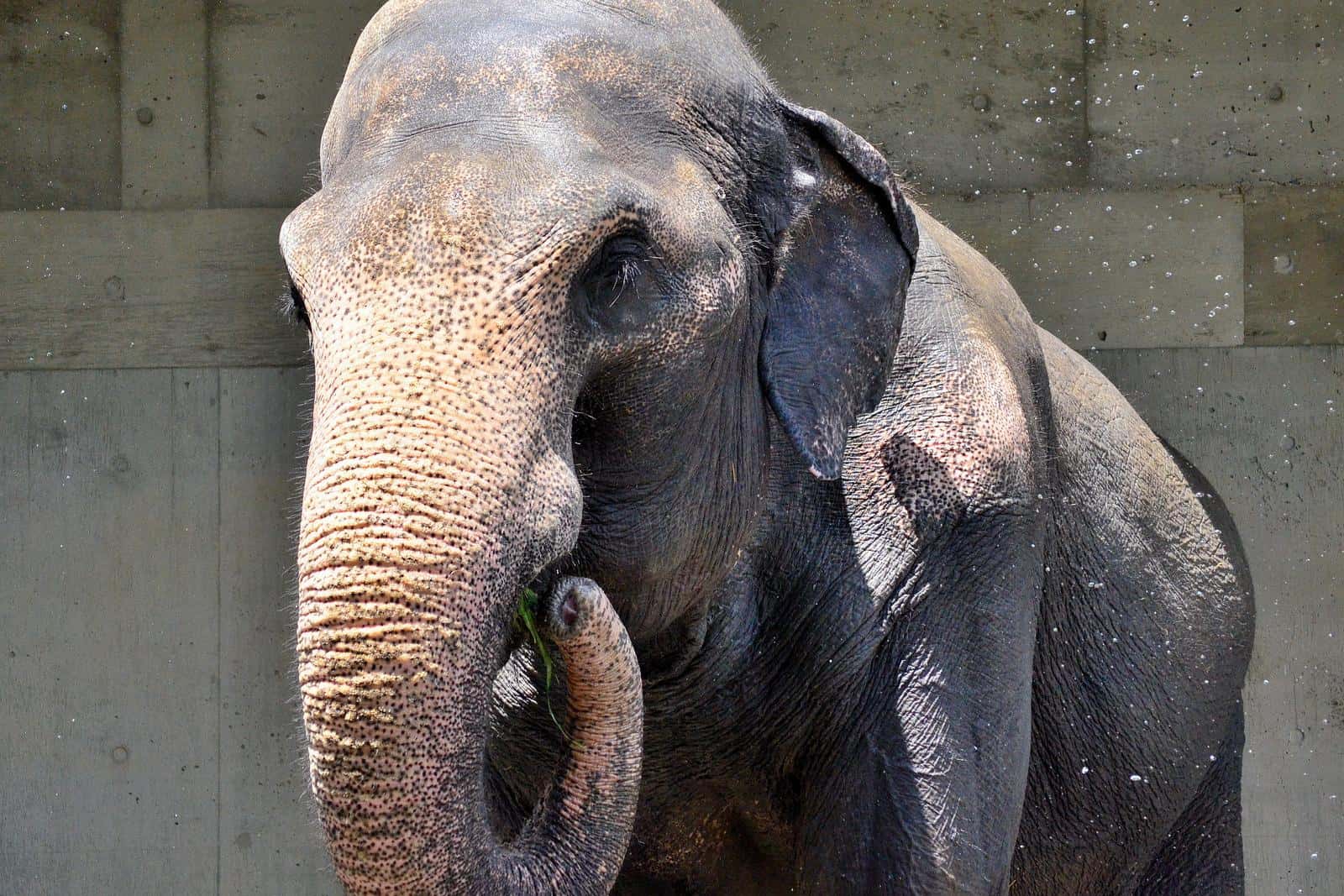
The Indian Elephant has no bones in its trunk.
- The trunk of this elephant contains no bones. Though it includes both the upper lip and the nose, the entire trunk is made up of 40,000 muscles, which is about 62 times the number of muscles in the entire human body.
- Mothers have the help of other females in their herd to raise their calves. These helpful females are referred to as aunties, and the fathers play a less significant role.
- During the hot months, they can drink up to 200 liters of water per day. This heavy drinking suggests that the mammal can drink their weight in water almost three times a month
- Indian elephants weigh between 6,000 and 8,000 pounds as an adult, measuring between 18 and 21 feet in length. This length includes their body, head, and trunk. Even a baby is fairly large, measuring weighing up to several hundred pounds as well.
- An Indian elephant spends 19 hours a day just eating.
Scientific Names
The Indian elephant goes by the scientific name Elephas maximus indicus. They belong to the kingdom Animalia and class Mammalia. These elephants come from a family called Elephantidae and have a subspecies called E. m. indicus. They belong to the order called Proboscideans.
The word elephas is the Latin influence for elephant, but it comes from the Greek word ἐλέφαντος, which could’ve been influenced by the Egyptian word for ivory or elephant. Interestingly, ivory’s etymology comes directly from Latin and Greek interpretations of the word elephant, making them interconnected forever.
Indicus is rooted in the Ancient Greek from Ἰνδία, which means India. Essentially, the interpretation of this name simply means that the animal is a large elephant from India.
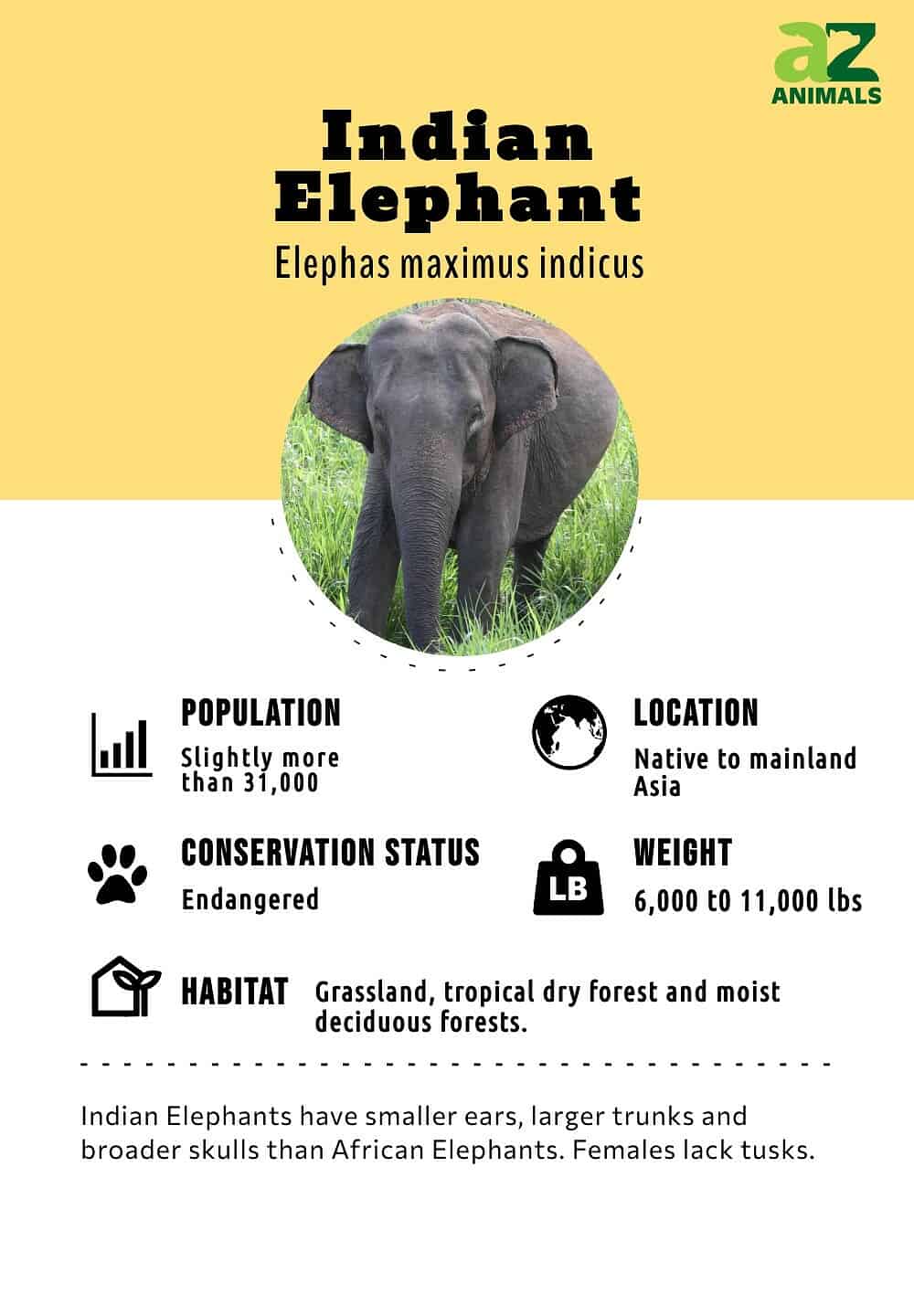
Appearance
These elephants are huge animals with a size of about 18 to 21 feet, weighing in at up to 8,000 pounds as a male. Though their head is large heads, their necks are small. With such a high weight, the legs take on much work to carry them.
While other elephant breeds have shorter tails, the tail of this elephant is incredibly long. Matching their grayish color, the tail sometimes goes longer than its knees, potentially brushing the ground with the coarse hair that hangs from the bottom of the tail.
The trunks are perhaps the most fascinating feature of the Indian elephant. While the trunk makes up quite a large portion of the body, it doesn’t contain any bones at all. Instead, as described in the above facts, this powerful extremity contains a total of 40,000 muscles, which are broken down into 150,000 separate sections.
This muscled trunk is necessary for the elephant’s survival, allowing them to cool off with splashing, and to hydrate by bringing water to their mouth, tearing down food to eat, and expressing themselves.
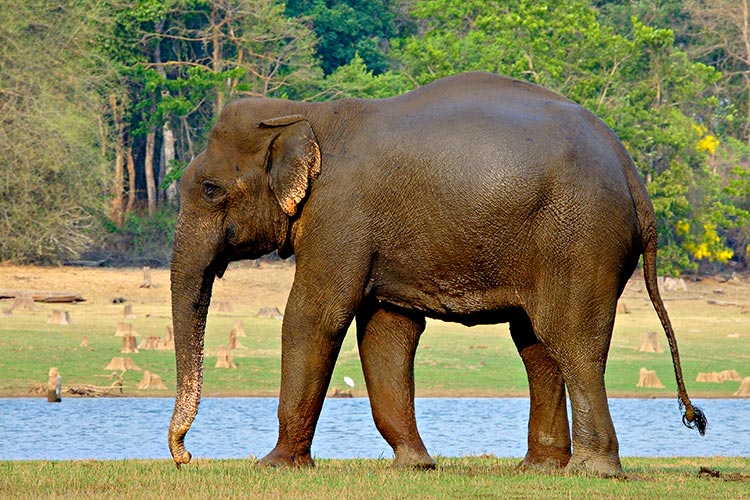
Their trunk is essential for survival, bringing water to their mouth and tearing down food to eat.
Behavior And Characteristics
These elephants are diurnal which means that they are the most active during the day and sleep at night. However, contrary to that, these animals are also nocturnal in nature which means that some of them can also be highly active during the night.
These elephants are highly social and are known to exist in stable groups. The groups are usually matriarchal and consist of 20 female Indian elephants that are very closely related. The groups are headed by the oldest female elephant. The leader usually guides the whole group in the quest for food and water.
These elephants are known to be intelligent and display a wide variety of emotions like joy and grief. The Indian elephants are known to make a variety of sounds – both low and high-pitched – to communicate.
The groups that these elephants exist in are called herds. With their family, the Indian elephant takes 19 hours a day to eat, which produces a large amount of waste – 220 pounds of dung daily, to be exact. They will travel up to 125 miles a day to keep themselves active as they seek out their next source of nutrients. Even when they sleep, most elephants will remain standing while in the wild.
These elephants are known to travel from one forest to another and are also known to often stay in different forests at different periods. However, male Indian elephants like to live in solitude, especially in their younger years.
Characteristics

An Indian elephant trunk has one small finger-like point.
Indian elephants and Asian elephants in general are smaller than African elephants. They also tend to have the highest body point at the tip of the head. Their trunk tip has one small finger-like point and their back is level to their heads if not a touch shorter.
Indian elephants reach a shoulder height of about 6 to 10 feet and they can weigh anywhere from 4,4000 to 11,000 lbs. They also have 19 pairs of ribs. Their skin color tends to be lighter than other species with small patches of darker skin. Females also tend to be smaller than males.
Additionally, Indian elephants have smaller ears and larger skulls. Their trunks are often bigger than African elephants and their toes are wider as well. However, unlike their cousins, Indian elephants’ abdomen is proportionate with their body weight whereas the African elephant has a bigger stomach compared to their skull size.
Habitat

The Indian elephant is found in many parts of Southeast Asia.
These elephants exist in a variety of habitats and prefer to live in forests, grasslands, and scrublands. Besides that, they can also be found in cultivated forests. When they sleep at night in ordinary circumstances, herds that reside near villages may reverse these habits to remain vigilant against potential human threats.
They can be found in several parts of Southeast Asia including Cambodia, the Republic of the Union of Myanmar, Bhutan, Bangladesh, Pakistan, Nepal, Malaysia, Vietnam, and Thailand. These regions provide Indian elephants with a substantial number of plants to feast on, but they are dwindling.
Humans and Indian elephants in the region are starting to see their habitats collide. This combination can cause a major conflict, forcing them to give up their natural habitat and dwindle in numbers. While there are efforts to correct this conflict, humans have been accosted, injured, and even killed in the process.
Diet
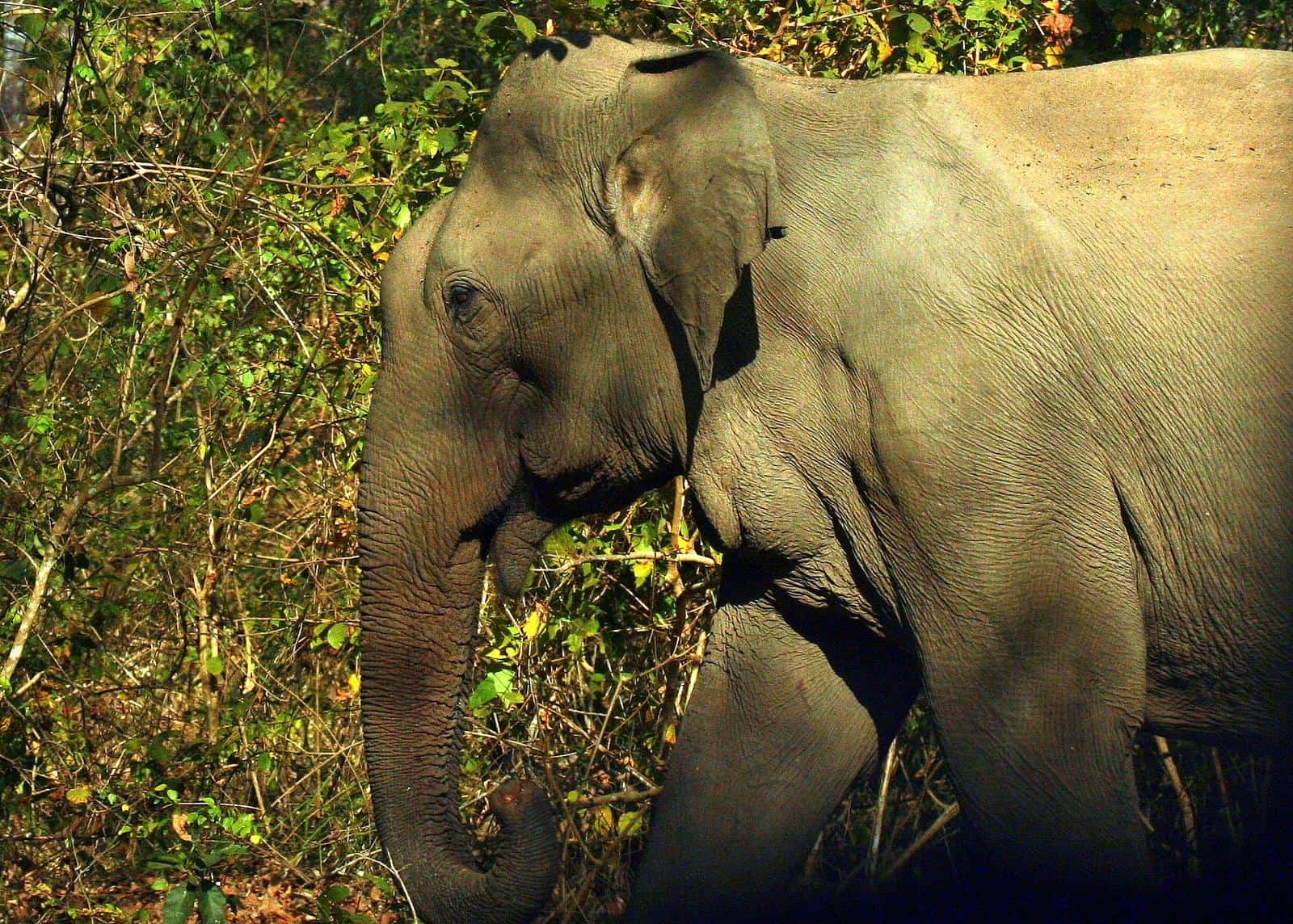
Mostly plant eaters, with a diet that includes grass and leaves.
These elephants are majorly plant-eaters (i.e., megaherbivores) and are known to eat about 330 pounds of food each day. Their diet majorly includes grass, leaves, barks, stems, and roots.
Apart from that, these huge mammals also feed on bananas, sugarcane, and rice. They love grazing on tall grasses and are known to remove the shoots and blades of these grasses very skillfully.
As plentiful as this food may sometimes be, the search can be dangerous for humans and elephants alike.
What Does An Indian Elephant Eat?
These elephants are majorly plant-eaters. They usually feed on grass, leaves, bark, stem, root, and shoots. They also feed on bananas, sugarcane, and rice. Apart from that, they graze on tall grass. Though the blades and shoots can be harmful to their stomach and mouth, the strong trunk of the Indian elephant allows them to remove these parts before they chew them up.
As the habitats of the Indian elephant become smaller, some of their journeys for nutrients take them fairly close to the human populations.
What Eats Indian Elephants?
Due to their humongous size and weight, these animals have very few predators. Bengal tigers are known to eat them, but they hunt down only the baby Indian elephants as they are easy to hunt owing to their smaller size as compared to the larger ones.
Many of the reports of these tiger attacks are in the Jim Corbett National Park in Uttarakhand.
Predators And Threats
As stated above, there are almost no predators (in terms of the natural food chain) for the Indian elephant. Bengal tigers are one of the prominent predators of the Indian elephant, but tigers hunt down the babies of these elephants owing to their size. Some of these instances have even appeared in the news, tracing back to a zoo in Uttarakhand, India.
The biggest threat to the Indian elephant is humans and their daily life. Poaching remains a major threat to these animals as humans use their tusks for ivory, but the threat goes beyond that. The reduced habitat has caused aggressive confrontations between the humans nearby. As the elephants look for food in farmlands, these humans lose out on their income. However, the violent response from both sides has led to the death of nearly 500 humans each year.
Reproduction, Babies, And Lifespan
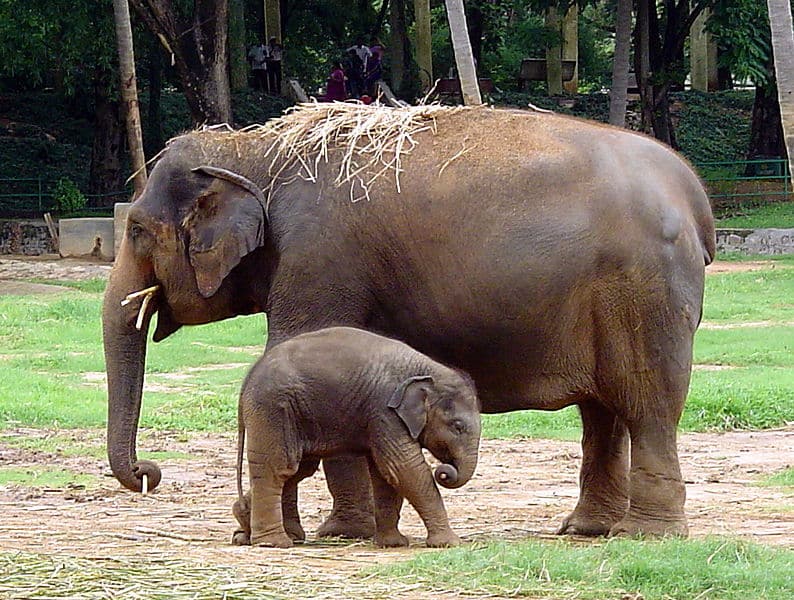
Gestation periods of an Indian elephant are usually 22 months long.
The Indian elephants are known to mate by rubbing their bodies against each other and even wrapping their trucks together. Male Indian elephants then mount the female from behind. The sexual act lasts for about two minutes after which, the male Indian elephant stays near the female Indian elephant to ward off other males from around her.
Males that fall in the age bracket of 40 to 50 years are most likely to mate with females for babies. however, the courtship between the male and the Indian elephant female is fairly short-lived. Females are about 10 years old when they can start producing babies, which are referred to as calves. The gestation period lasts for around 22 months after which they give birth to calves or baby elephants.
A baby Indian elephant usually weighs around 220 lbs at birth. The mother and other female ‘aunts’ take care of the baby. The calf sticks around with its mother for about five years after which the male calves move out of the herd while the female ones stay behind.
An Indian elephant usually has a lifespan of about 48 years. However, conservation efforts and captivity influence that age.
Population
Indian elephants can be found throughout mainland Asia, with up to 31,368 elephants in India alone. Over half of these elephants are found in the southern region. Myanmar has the second-most Indian elephants at about 4,000 to 5,000, though the population is greatly broken up.
A few thousand Indian elephants each are found in Malaysia and Thailand, but the number is only in the hundreds in Bangladesh, Bhutan, Laos, China, and Cambodia. There are a few areas in southern Vietnam with elephants, though their numbers are as low as 70 Indian elephants in total.
The Indian elephant is on the ICUN Red List as an endangered species. Since the 1950s, the total number of Indian elephants has decreased by 50%, which is what landed the species on the list in 1986. The IUCN’s last update on the population in 2019 indicated that current numbers were needed to see how many are currently left.
Types Of

Baby Borneo elephant – the smallest of the Asian elephants is still the largest mammal.
©iStock.com/jacus
There are currently four recognized subspecies of the elephant, including the Indian elephant (Elephas maximus indicus). Those are:
Bornean elephant (Elephas maximus borneensis). Critically endangered, the Borneo elephant is the smallest subspecies of Asian elephants.
Sumatran elephant (Elephas maximus sumatranus). This elephant, with only a population of nearly 2,800, is listed as critically endangered.
Sri Lankan elephant (Elephas maximus maximus). This pachyderm is thought to be one of the rarest and largest land mammals.
In The Zoo

Indian elephant at Whipsnade Zoo
©Lumos3 at the English language Wikipedia / Creative Commons
These elephants are often found to exist in captivity, particularly in India and Thailand. They are often used as an object of fascination in zoos and have often been used to uplift the tourism industry. In the United States, it is difficult to find an Indian elephant, as there are many groups against holding them in captivity. The only zoos that have elephants often source them from Africa.
Much of the reason that these animals are in zoos is an effort to protect them from humans and domesticate them.
View all 39 animals that start with IIndian Elephant FAQs (Frequently Asked Questions)
Are Indian elephants’ carnivores, herbivores, or omnivores?
Indian elephants are herbivorous in nature and are majorly plant-eaters. They usually feed on grass, leaves, roots, bark, stems, and shoots. They also eat bananas, sugarcane, and rice.
Where do Indian elephants live?
The Indian elephants are known to exist in Bangladesh, Bhutan, Myanmar, Thailand, India, and Cambodia among other places.
How many Indian elephants are left?
According to the IUCN red list, there are about 26000 to 30000 Indian elephants left around the world.
What does the Indian elephant eat?
The Indian elephants usually feed on grass, leaves, roots, bark, stems, and shoots. They also eat bananas, sugarcane, and rice.
What is the difference between an Indian elephant vs. an African elephant?
Indian and African elephants are known to have visible differences in their appearances. The Indian elephants are smaller than the African ones and their ears are also smaller in size.
Meanwhile, in Indian elephants, only the males grow tusks. However, both males and females are known to grow tusks in African elephants.
What is the lifespan of the Indian elephant?
An Indian elephant can live for around 48 years.
What Kingdom do Indian Elephants belong to?
Indian Elephants belong to the Kingdom Animalia.
What phylum to Indian Elephants belong to?
Indian Elephants belong to the phylum Chordata.
What class do Indian Elephants belong to?
Indian Elephants belong to the class Mammalia.
What family do Indian Elephants belong to?
Indian Elephants belong to the family Elephantidae.
What order do Indian Elephants belong to?
Indian Elephants belong to the order Proboscidea.
What type of covering do Indian Elephants have?
Indian Elephants are covered in Leathery skin.
What genus do Indian Elephants belong to?
Indian Elephants belong to the genus Elephas.
What are some predators of Indian Elephants?
Predators of Indian Elephants include humans and tigers.
What are some distinguishing features of Indian Elephants?
Indian Elephants have long trunks and large feet.
How many babies do Indian Elephants have?
The average number of babies an Indian Elephant has is 1.
What is an interesting fact about Indian Elephants?
Indian Elephants are found throughout southeast Asia!
What is the scientific name for the Indian Elephant?
The scientific name for the Indian Elephant is Elephas maximus indicus.
How fast is an Indian Elephant?
An Indian Elephant can travel at speeds of up to 27 miles per hour.
Thank you for reading! Have some feedback for us? Contact the AZ Animals editorial team.
Sources
- WWF, Available here: https://www.worldwildlife.org/species/indian-elephant
- Wikipedia, Available here: https://en.wikipedia.org/wiki/Indian_elephant
- Animals Network, Available here: https://animals.net/indian-elephant/
- Kaziranga National Park, Available here: https://www.kaziranganationalpark.com/elephant.htm
- National Geographic, Available here: https://www.nationalgeographic.com/animals/mammals/a/asian-elephant/
- Elephant World, Available here: https://www.elephant-world.com/elephant-reproduction/
- Animalia, Available here: http://animalia.bio/indian-elephant

















